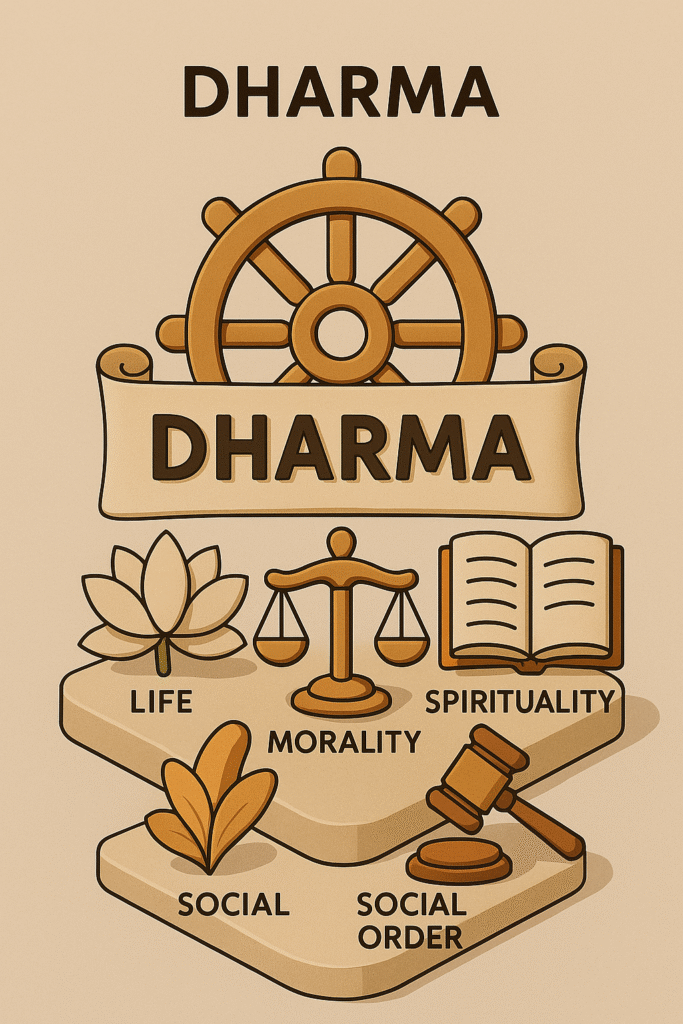
Dharma is a complex and multifaceted concept , whose meaning may vary depending on time, place, and context. It is linked to the fundamental principles of life , spirituality , morality , and rules of social life . Dharma has special significance in the Indian tradition and it has been understood from a broad perspective. Dharma can be discussed in detail in the following points :
1. The original meaning of religion
- ” Dharma ” is derived from the Sanskrit word ” dhr ” , meaning ” to hold ” or ” to support. “
- This is the principle that keeps society , nature , and individual life in balance.
- In Indian philosophy, the meaning of religion is not limited only to worship method or religious belief , but it is a way of life.
2. Differences of religion
There are several types of religion , which reflect its broad meaning :
- Common Dharma ( Common Morality ): Adherence to truth , non-violence , kindness , benevolence , and other moral values.
- Vishesh Dharma ( Individual duty ): Duties of a person according to his status , class and circumstances . For example , Dharma of a king , Dharma of a teacher , etc.
- Sanatan Dharma : In the Indian tradition ” Sanatana Dharma ” means eternal and universal truth , which does not depend on any particular time or place.
- Legal religion : Based on Vedic traditions and texts.
3. Principles of religion
To understand religion properly it is necessary to know its principles :
- Truth : Following the truth is the basis of religion.
- Non-violence : Refrain from any type of violence.
- Justice : To live a just life and treat others equally.
- Duty : Fulfilling your responsibilities and duties.
- harmony : Maintaining balance between society and nature.
4. Dharma and Adharma
Dharma and Adharma are opposite to each other . Dharma is that which provides stability and peace to life and society , while Adharma means violating those principles which are harmful to life and society.
5. Sources of religion
The main sources of knowledge of religion are :
- ethology : Vedas , Upanishads , Geeta , Mahabharata , Ramayana etc.
- Commemoration : Manusmriti , Yajnavalkya Smriti etc.
- Behaviour : Moral and cultural traditions prevailing in the society.
- Words of saints and gurus : Spiritual guidance.
6. Modern view of religion
Today religion has been limited to only worship practices , but the real purpose of religion is to serve humanity , follow morality , and spread universal love.
- Religion should also be seen from a scientific perspective and a humanistic point of view.
- The goal of different religions is the same – to achieve spiritual advancement and peace in life.
7. Influence of religion
- personal life : Religion teaches a person morality , restraint , and conduct.
- Social Life : Religion ensures unity , harmony , and justice in the society.
- Spiritual growth : Religion leads to purification of the soul and union with the Supreme Being.
conclusion
Religion is not limited to customs and rituals. It is a way of life that encompasses humanity , morality , and spirituality. The purpose of religion is to provide a higher purpose and meaning to human life. A person who follows religion in the true sense is one who walks on the path of truth , non-violence , and justice and works for the welfare of society.
The original meaning of religion
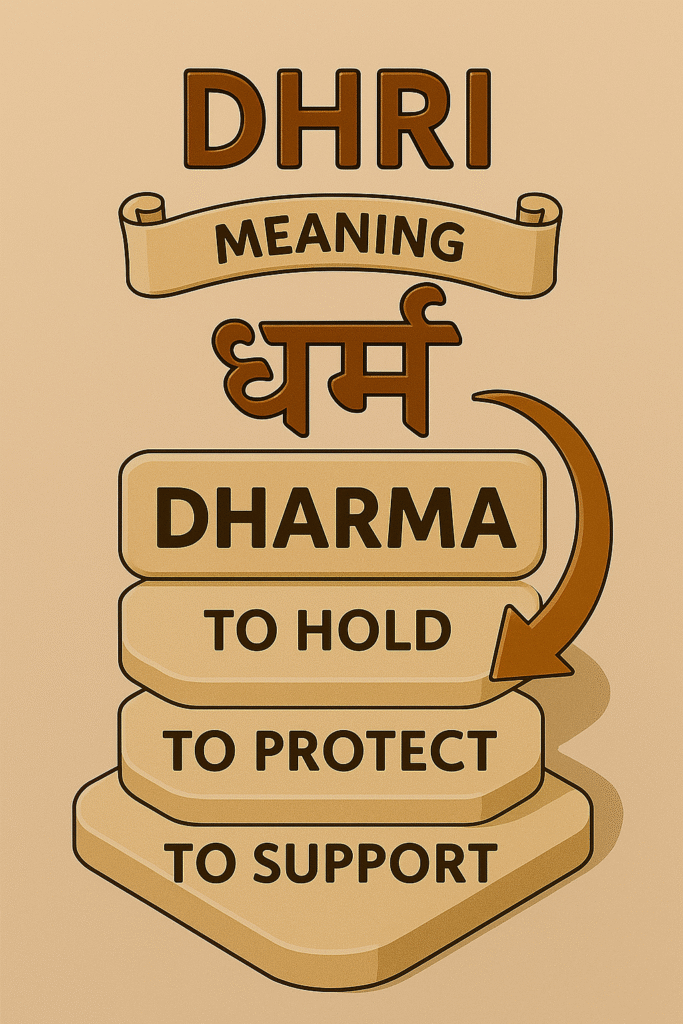
The original meaning of religion Indian tradition and philosophy is very broad and deep. The word Dharma is derived from the Sanskrit word ” Dhri “. , meaning ” to hold , ” ” to protect ,” or ” to support. “
The basic purpose of religion is to provide such principles which :
- Individual and society Guide in the right direction.
- Nature and life Establish harmony and balance.
- Morality and duty Ensure compliance with .
Aspects of the original meaning of religion :
Spiritual perspective :
- Religion is the power that connects a human being to his soul.
- It is the bridge between individual and universal consciousness.
Moral point of view :
- Dharma is the adherence to fundamental principles such as truth , non-violence , compassion , and justice.
- It teaches the difference between right and wrong.
Social perspective :
- The purpose of religion is to establish unity and harmony in the society.
- It teaches to follow social duties and responsibilities.
Personal vision :
- Dharma means right conduct and guidance for a person’s life.
- It makes a person aware of his duties and rights.
Scientific view :
- The basic meaning of religion is to follow the rules of life and natural principles.
- It guides us to live in harmony with nature.
The essence of ” Dharma ” :
- Religion is not a narrow ideology , but it is an eternal and universal way of life Is.
- It is a collection of principles and rules that make life meaningful , balanced , and joyful. Let’s make it.
In short , the basic meaning of religion is the path or principle that preserves human being , society , and nature while leading them to higher spiritual and moral state.
Differences of religion
Differences in religion In the Indian tradition, Dharma has been understood from a wide range of perspectives. Dharma has been classified in different contexts , which determine the duties and morals of the person , society , and time.
1. Samanya Dharma ( General Moral Principles ):
- This is called ” ordinary religion “ It is also called.
- These are the qualities that every person should have , such as :
- Satya ( being truthful )
- Ahimsa ( abstinence from violence )
- Daya ( compassion towards living beings )
- pardon ( forgiveness )
- Self-restraint ( control over the senses )
- Shaucha ( internal and external purity )
- Santosh ( Satisfaction )
Target : To bring balance in society and life by following moral and human values.
2. Vishesh Dharma ( Individual Duty ):
- This is called ” Swadharma “ It is said.
- This Dharma depends on the person’s Varna ( caste ), Ashrama ( stage of life ), and his circumstances.
- Varna Dharma : Duties according to the person’s social class ( Brahmin , Kshatriya , Vaishya , Shudra ) .
- Ashram Dharma : Duties according to stages of life ( Brahmacharya , Grihastha , Vanaprastha , Sannyasa ) .
- Example :
- The religion of a Brahmin is to propagate education and knowledge.
- The duty of a Kshatriya is to protect the society.
- nurture the family and society .
3. Sanatan Dharma ( Eternal Religion ):
- It is based on universal and eternal principles , which are beyond time and space.
- This includes truth , non-violence , compassion , and equality towards all living beings.
- This religion gives priority to balance with humanity and nature.
- Example : “ Dharma ” that is applicable in all ages , such as truth and justice.
4. Yugdharma ( Religion according to the times ):
- It is determined according to the circumstances of the era and society.
- The form and duties of religion may change in each era.
- Example :
- Truth and penance were predominant in Satyayuga.
- In Kaliyug, service and devotion are considered important.
- Example :
5. Apaddharma ( emergency religion ):
- This Dharma applies in times of crisis and emergency.
- When general rules cannot be followed , whatever is appropriate to solve the problem is Dharma.
- Example : Stealing can also be considered as a religion when one is dying of hunger.
6. Communal religion :
- It is classified on the basis of religious beliefs and practices , such as :
- Hinduism
- Buddhism
- Jainism
- islam religion
- Christianity
- These religions are based on specific traditions , texts , and worship methods .
7. Folk religion ( social religion ):
- It is the adherence to the moral values and traditions established in the society.
- , importance is given to social welfare , harmony , and mutual cooperation.
8. Difference between Dharma and Adharma :
- Religion is that which is in the interest of life , society , and nature.
- Adharma is that which harms these three , like violence , lying , injustice , and greed.
conclusion :
Differences in religion This shows that religion is not limited to religious rituals , but it affects every aspect of human life – spiritual , moral , social , and personal . Following religion provides guidance to the individual and society and makes life balanced and purposeful.
Principles of Religion
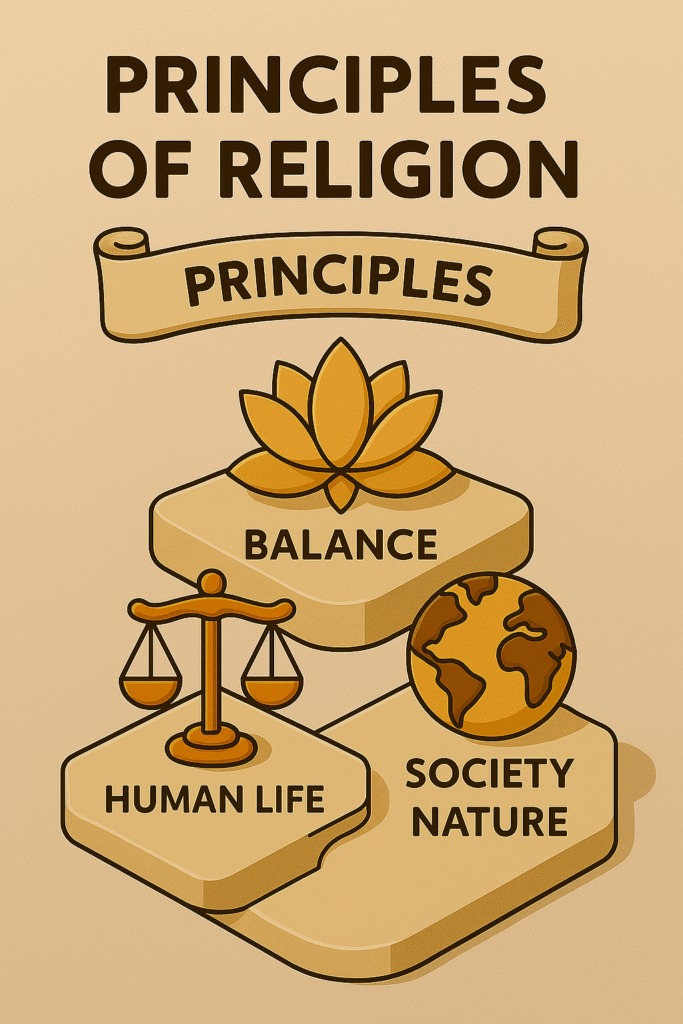
Principles of religion They are the fundamental rules and guides that are necessary to maintain balance in human life , society and nature. These principles provide the basis for individual , social and spiritual advancement. The principles of Dharma are elaborately described in Indian philosophy and scriptures.
1. Truth
- Truth is the main basis of religion. It means maintaining truth in your thoughts , words , and actions.
- One should follow the truth in any situation.
- Geeta It is said : ” Satyaam Bruyat , Priyam Bruyat ” ( Speak the truth , but speak the truth ) .
- Truth not only reflects honesty towards the external but also towards the soul .
2. Non- violence
- Nonviolence means avoiding any kind of physical , mental , or emotional violence.
- This principle symbolizes respect for life and establishes peace and harmony in the society.
- Mahatma Gandhi described non-violence as the highest principle of religion.
3. Purity
- Cleanliness means external and internal purity.
- Outdoor defecation : cleanliness of the body and the environment.
- Internal purity : purity of thought , speech , and action , such as refraining from greed , anger , and jealousy.
4. Compassion
- Daya means having compassion and sympathy towards all living beings.
- Understanding the suffering of others and helping them is an integral part of religion.
- ” Vasudhaiva Kutumbakam ” ( the whole earth is one family ) is based on compassion.
5. Forgiveness
- Forgiveness means forgiving the mistakes of others and not holding grudges against them.
- It helps in maintaining peace of soul and mental balance.
- Mahabharata It is said that forgiveness is a sign of bravery.
6. Contentment
- Contentment means being satisfied with what you have .
- Avoiding greed and dissatisfaction is an important aspect of religion.
- Contentment is the basis of peace and stability of mind.
7. Justice
- The basic purpose of religion is to establish justice.
- It ensures equality and fairness between the individual and the society.
- applies not only to others , but also to oneself.
8. Patience
- Patience is the ability to face difficulties calmly.
- It promotes stability and tolerance of mind.
- Religion teaches that patience is the way to success in every aspect of life.
9. Asteya (Non-stealing)
- This means not encroaching upon someone else’s property or rights.
- It promotes honesty and self-reliance.
- Yoga Sutras Asteya has been described as an important principle of self-purification.
10. Swadharma (Personal Duty)
- The religion of every person is determined according to his status and responsibilities.
- It is said in the Gita : ” Swadharme nidhanam shreyah ” ( It is best to die in one’s own religion ) .
- A person’s duty is towards his society , family , and himself.
11. Austerity
- Tapasya means controlling your senses and desires.
- This is the path of purification of the soul and self – discipline.
- Through penance a person achieves his spiritual goal.
12. Equality
- Equality means treating everyone equally.
- Religion teaches that it is unrighteous to discriminate on the basis of caste , colour , and status.
- Equality establishes unity and equality in the society.
13. Altruism
- Helping others and working for the welfare of society is the main principle of religion.
- It is said in Indian culture : ” Paropkaryaaya Punyaya ” ( Charity is a virtuous act ) .
conclusion :
help to make life ethical , balanced , and meaningful. These principles provide guidance for the advancement of the individual soul , harmony in society , and harmony with nature. Following these principles leads to the welfare of both the individual and society.
Dharma and Irreligion
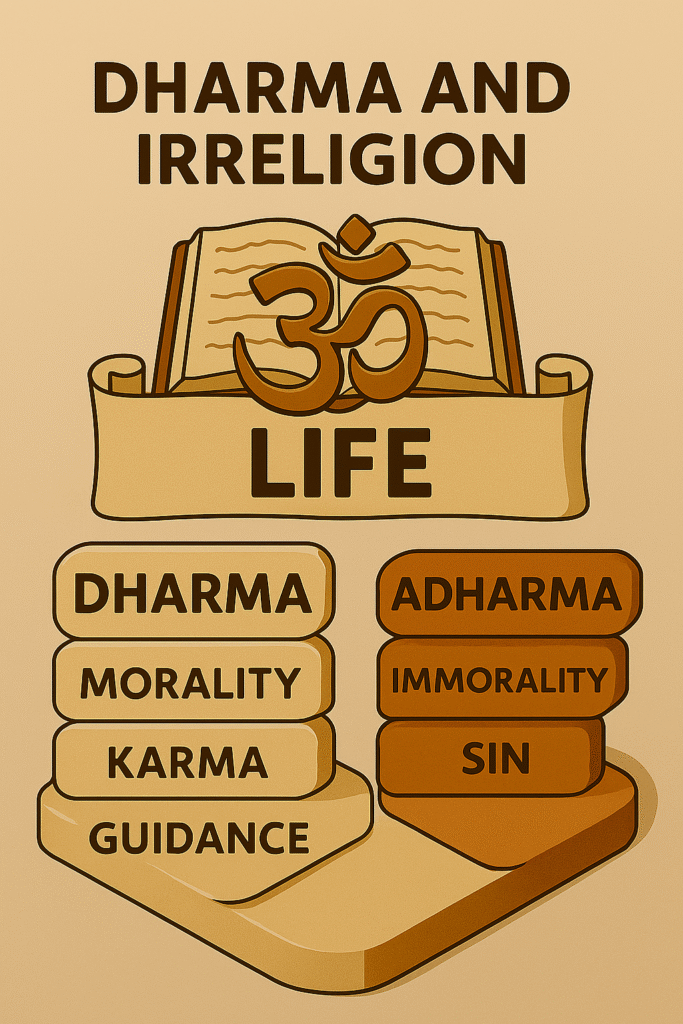
Dharma and Irreligion Indian philosophy and scriptures explain the fundamental principles of life. Knowing and understanding the difference between Dharma and Adharma is essential to lead human life in the right direction. Both concepts play an important role in morality , karma , and guidance of life.
Religion : Definition and Nature
- Religion means following those principles of life which are necessary for the welfare of society , individual , and nature.
- It is based on virtues like truth , justice , non-violence , and compassion.
- The purpose of religion :
- To instill morality and discipline in life.
- Maintaining peace and harmony in the society.
- Purification of the soul and spiritual advancement.
Characteristics of religion :
- Satya ( being truthful )
- Ahimsa ( not harming anyone )
- cleanliness ( purity )
- Daya ( compassion towards all beings )
- Justice ( equality and fairness )
Example of religion :
- Lord Krishna said in Gita , ” Protection of Dharma leads to welfare of life and society. “
- Shri Ram’s observance of Dharma in Ramayana ( obedience to ancestors , ideals of truth and justice ) .
Irreligion : Definition and Nature
- Adharma is the opposite of Dharma. It means actions or thoughts that are harmful to society , individuals , and nature.
- Adharma represents actions that are based on injustice , falsehood , violence , and greed.
- Effect of injustice :
- Spread of unrest and disturbance in life.
- Imbalance and disintegration in society.
- Degradation of spirit and decline of morality.
Signs of injustice :
- untruth ( telling a lie )
- Violence ( harming someone physically , mentally or emotionally )
- Injustice ( taking away the rights of others )
- Greed ( excessive greed )
- Envy ( hatred towards others )
Example of wrongdoing :
- , deceit and injustice of Duryodhana and Shakuni in Mahabharata .
- Ravana’s abduction of Sita and violation of Dharma due to his ego.
Main difference between Dharma and Adharma :
| aspect | Religion | wrongdoing |
| Principle | truth , justice , non-violence , compassion | falsehood , injustice , violence , greed |
| Objective | Welfare of society and the soul | Self – centred and harmful to society |
| Effect | peace , balance , progress | unrest , imbalance , collapse |
| Base | Morality , according to scriptures | Immorality , selfishness , and renunciation of duty |
| Example | Shri Ram , Yudhishthira , Mahatma Gandhi | Ravana , Duryodhana , Shakuni |
The struggle between Dharma and Adharma
The conflict between Dharma and Adharma is depicted in Indian mythology and philosophy as ” Dharmic war ” or ” Dharmic conflict ” .
- War of Mahabharata : It was a conflict between Dharma ( Pandavas ) and Adharma ( Kauravas ) .
- Ramayana : The war between Shri Ram ( Dharma ) and Ravana ( Adharma ) , which symbolizes the victory of Dharma and the downfall of Adharma.
The results of Dharma and Adharma ( depending on Karma ):
- Salvation for a person who follows religion And one gets respect in the society.
- a person who walks on the path of evil And experiences suffering because of his actions.
Lord Krishna said in Gita :
” Dharmo rakshati rakshitah “
( Dharma protects the one who protects Dharma . ) And
about Adharma :
” The end of Adharma is destruction. “
conclusion
Dharma and Adharma are two aspects of life that distinguish between right and wrong. Following Dharma leads us to peace , stability, and spiritual advancement , while Adharma leads to the downfall of our life , society , and soul. Following Dharma with right judgment and morality is the highest goal of human life.
Sources of Religion
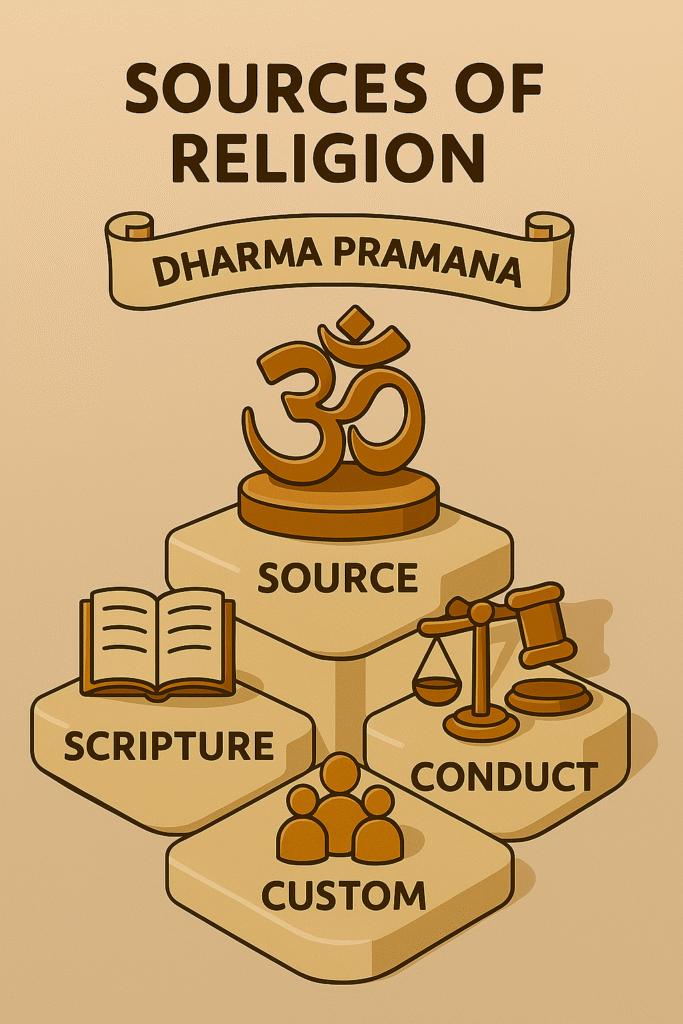
Sources of religion Indian philosophy and tradition have the fundamental basis of religion , which explains where the knowledge and rules of religion come from. These sources guide the moral , spiritual and social life of society and the individual. Four major sources of religion have been considered , which are called ” Dharma Pramana “. It is also called.
1. Shruti ( Vedas )
- Definition :
Shruti means ” that which has been heard. ” It is the most ancient and main source of religion. Shruti is based on the Vedas , which were heard and compiled by sages as divine knowledge. - Source : Four Vedas ( Rigveda , Yajurveda , Samaveda , Atharvaveda ) .
- features :
- Shruti provides the eternal and unchanging principles of Dharma.
- It is the basis of religious rituals , yagyas , and Brahmanology.
- Example :
- Eternal religious principles like truth , non – violence and compassion.
- Rules of sacrifice and rituals.
2. Smriti ( Dharmashastra )
- Definition :
Smriti means “ that which has been remembered. ” These are the texts that present the essence of the Vedas in simple language and systematize social , ethical and legal rules. - Source :
- Manusmriti
- Yajnavalkya Smriti
- Narada Smriti
- features :
- Smriti interprets religion according to time and society.
- It clarifies personal , social , and legal duties.
- Example :
- Varnashram Dharma , Grihastha Dharma , King’s Dharma.
3. Aachar ( behaviour of society )
- Definition :
Aachar means ” moral and religious conduct accepted by the society. ” It is the practical form of religion. - Source :
- Traditions prevalent in the society.
- Clan , caste , and regional customs .
- features :
- Ethics establishes harmony between the individual and society.
- This makes religion practical and applicable.
- Example :
- Marriages , festivals , and worship practices.
- Hospitality , charity , and service.
4. Morality ( behavior of gentlemen )
- Definition :
Morality means “ the conduct of gentlemen. ” It is the life of ideal men and great men who follow high standards of morality and religion. - Source :
- Rishis – the ideals of sages , saints , and religious leaders.
- Ancient traditions and moral values of religion.
- features :
- It presents religion at a personal and idealistic level.
- Gentlemen are the guides of religion for the society.
- Example :
- Shri Ram’s adherence to truth and religion.
- Mahatma Gandhi’s path of truth and non-violence.
Other sources ( according to time and society ):
- Tactics ( Arguments ):
- To reason and think about religion.
- Rational decisions for the betterment of society.
- Place and time :
- Development of the rules of religion according to time and place.
- yugadharma And following religion according to the circumstances.
- Shastras ( other texts ):
- Mahabharata , Ramayana , Geeta , Puranas.
- These provide the ideals of religion and guidance for living.
Importance of these sources of religion :
- Social Cohesion :
The sources of religion maintain discipline and unity in the society. - Spiritual advancement :
These sources show the path to purification of the soul and enlightenment of the Supreme Being. - Personal Development : The rules of religion
make a person moral , disciplined , and restrained. - Flexibility according to time and situation :
Different sources of religion keep it relevant according to time and society.
conclusion :
The sources of religion are the guides that provide the right direction to life. These sources not only determine religious duties , but also provide the basis for morality , progress of society , and purification of the soul. Through these four basic sources of religion, human life can be made ideal and harmonious.
Modern view of religion
In the modern era, religion is not seen as limited to only religious rituals and traditions , but it is seen as a means of uplifting the moral , social , and spiritual aspects of human life. The modern view of religion is based on establishing a balance between the individual and society , adopting universal values and reconciling with science and technology.
1. New meaning of religion
- Personal morality :
Religion now guides the individual’s moral conduct and decision between right and wrong.- Such as : truth , non-violence , kindness , and honesty.
- Universal Humanity :
Dharma is seen as having common values among all religions , which promote humanity , love , and compassion. - Spirituality and Self – motivation :
Religion is now seen as a means to inner peace and enlightenment of the soul rather than external rituals.
2. The modern role of religion in society
- Equality and Social Justice :
- Religion is being made the basis of equality to end discrimination on the basis of caste , gender and religion .
- Example : Baba Saheb Ambedkar made religion a medium of equality and justice.
- Cultural Integration :
- Religion is seen as a cultural identity , which establishes unity and harmony in society.
- Religion and education :
- Religion has now been made the basis of moral education , which teaches children the knowledge of right and wrong and to follow human values.
3. Coordination of religion and science
- Religion and Logic :
- In the modern approach, religion is being rationalized by separating it from superstition and conservative thinking.
- Example : Harmony between science and spirituality , like scientific importance of meditation and yoga.
- Nature and environment conservation :
- In modern religion, protection of environment has been considered a moral and religious responsibility.
- Example : Promoting ideas like “ Trees are Gods ” .
4. Religion and globalization
- Religion and Plurality :
- Religion has now become more of a global value than an individual concept , connecting different cultures and traditions.
- Example : Interfaith dialogue .
- Human form of religion :
- Religion is no longer limited to a single sect or scripture , but is seen as a symbol of global peace , compassion , and co – existence.
- Thoughts of Mahatma Gandhi : ” Religion is the path of truth and non-violence. “
5. Religion and personal freedom
- Personal nature of religion :
- In modern times, religion is being considered a matter of individual’s freedom and faith.
- Example : Individual’s personal decision in following religion and lack of dependence on any religious organization.
- Secularism :
- Religion is being kept separate from politics and government policies , so that all religions can be given equal respect.
- Example : Secular Constitution of India.
6. Challenges facing religion
- Religious fanaticism :
- The modern perspective challenges the violence and intolerance in the name of religion.
- Superstition and orthodoxy :
- The superstitions spread in the name of religion need to be removed through logic and scientific thinking.
- Religious divisions :
- An attempt to prevent divisions caused by the use of religion for social and political purposes.
7. The future of religion : reforming the modern outlook
- Making religion the basis of humanity :
- The aim of religion should not only be spiritual progress but also the welfare of society and environment.
- Religion and Technological Progress :
- Technology should be used to spread positive messages of religion and for social reform.
- Example : Promoting yoga , meditation , and spirituality through digital means .
- Incorporation of new values :
- Modern religion needs to adopt new values like tolerance , inclusiveness , and equality.
conclusion
The modern view of religion makes it a means of welfare of the individual and society. It rises above conservative ideas and is based on humanity , equality , and co – existence. Religion is no longer merely a religious or sectarian concept but has become a universal guide , which promotes morality , peace , and progress in modern life .
Influence of religion
Influence of religion Religion has a deep impact on the individual , society and the entire humanity. Religion is not limited to religious rituals only , but it affects every aspect of life. We can see the impact of religion at various levels : personal , social , and spiritual .
1. Personal impact
Religion affects a person’s life in many ways :
Spiritual advancement
- motivates a person towards self – knowledge and guides him towards purification of the soul.
- It provides an opportunity to a person to connect with his inner truth and divine.
- meditation , sadhana and worship lead to mental peace and inner balance.
Development of values and ethics
- teaches a person the difference between right and wrong.
- It develops moral values like truth , non-violence , compassion , kindness , and honesty.
- , patience , and forgiveness develop within the person .
Spiritual satisfaction and peace
- Religion gives purpose and direction to life , which gives inner peace to a person.
- This reduces mental stress and depression , because the person adopts a positive attitude towards life.
2. Social impact
Religion has a profound influence on society , which contributes to the overall development and harmony of society :
Social unity and cohesion
- Religion helps in maintaining collective unity and harmony in the society.
- It creates an atmosphere of equality and cooperation among different classes and castes.
- The aim of religion is to promote brotherhood , love , and tolerance in the society.
Social justice and equality
- Many religions have fought to end social discrimination and establish equality.
- E.g. Lord Buddha and Mahatma Gandhi fought against casteism and inequality in Indian society .
- protects the rights of women , Dalits and weaker sections.
promotion of morality in society
- Religion teaches moral values , which create discipline and organized life in the society.
- For example : Religion is clearly opposed to evils like adultery , theft , and violence.
Social work and philanthropy
- encourages social service , charity , and helping the poor.
- It contributes to secular institutions and charitable works , such as hospitals , schools , orphanages , etc.
3. Cultural influences
Religion also has a deep impact on cultural life :
Rites and traditions
- creates the traditions and customs of the society .
- gives importance to religious rituals and rites on major occasions of life ( birth , marriage , death ) .
- Religious festivals and worship processes maintain cultural diversity in the society.
art , music , and literature
- The religion has made significant contributions to the fields of art , music , and literature.
- Religious songs , hymns , poetry , paintings , and architecture of temples have enriched the cultural heritage of the society.
- For example , Indian religions encouraged many forms of dance and music , such as Bharatanatyam , Kathak , and choral singing.
4. Global impact
The influence of religion can now be felt on a global scale as well :
International peace and harmony
- Considering the positive aspects of religion , many religious leaders and organizations work for international peace , cooperation , and human rights.
- Religion tries to resolve conflicts and disagreements at the global level through sharing the values of humanity and peace .
- For example : Mahatma Gandhi , Martin Luther King Jr. , and the Dalai Lama preached peace and nonviolence through religion.
cultural understanding and tolerance
- Globally, many events and conferences are held to promote dialogue and understanding among different religions and cultures.
- It promotes religious tolerance and diversity around the world.
5. Environment and nature conservation
- Many religions teach respect and conservation of nature and the environment.
- Dharma is seen as establishing harmony with all aspects of life , including the environment.
- Example : Traditions like ‘ tree worship ‘ and ‘ worship of water sources ‘ in Hinduism contribute towards environmental protection.
6. The influence of religion in modern times
- Religion from a Scientific Perspective :
- Religion is no longer limited to only spirituality , but it also guides the moral upliftment of humanity and society.
- Modern science , such as mental health and yoga , accepts new research in accordance with the ancient principles of religion.
- Religion and Social Problems :
- is now seen as a way to help alleviate issues prevalent in society such as poverty , education , health , and violence.
- Social forms of religion have spread awareness and education within communities.
conclusion
Religion has a profound impact on every aspect of life , whether it is personal , social , cultural , or global. It is not limited to spirituality or religious rituals , but plays an important role in establishing morality , peace , and harmony in society. The right observance and understanding of religion can make life better and society more harmonious.